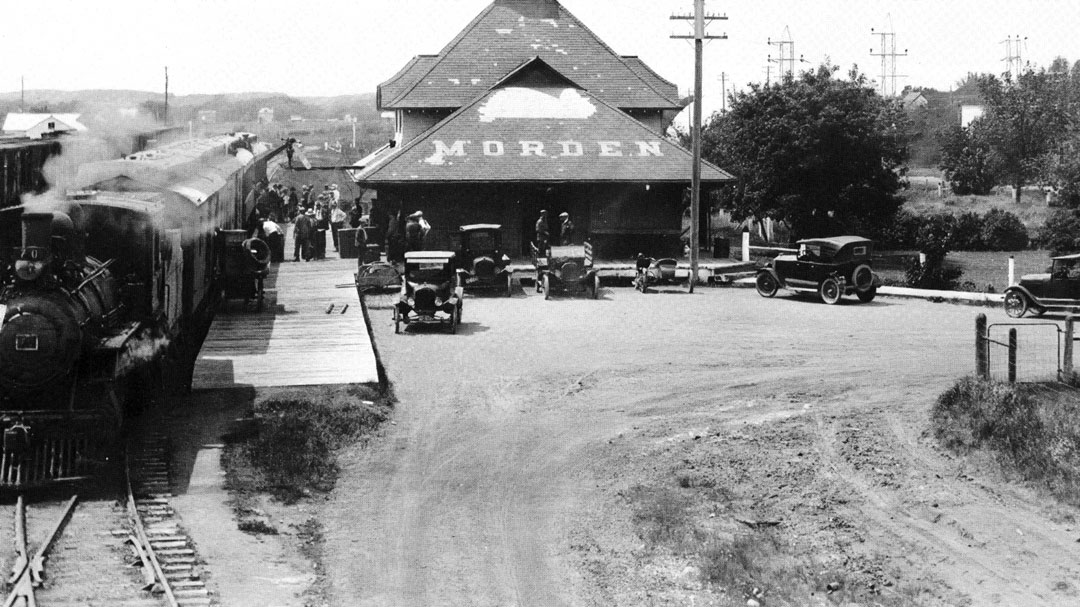Prehistoric Era: The Western Interior Seaway and Lake Agassiz
Millions of years ago, mosasaurs, plesiosaurs, giant turtles, and other large marine reptiles inhabited the Western Interior Seaway, a vast prehistoric saltwater body that covered much of present-day southern Manitoba, Saskatchewan, Alberta, and extended south to the Gulf of Mexico. As this sea receded, it was eventually replaced by the massive freshwater Lake Agassiz. This glacial lake played a crucial role in shaping the region’s rich, fertile soil.
Much later, indigenous inhabitants who constructed ceremonial mounds cultivated crops such as corn, squash, pumpkins, beans, and tobacco in the area.
When Lake Agassiz finally drained, it left behind nutrient-rich soil that supported diverse plant life, including saskatoons, plums, various berries, wild herbs, flowers, and shrubs. After the departure of the first indigenous societies, First Nations groups such as the Dene (Chipewyan), Cree, and Assiniboine inhabited the region.
European Exploration: La Verendrye and Alexander Henry
In the year 1738 La Verendrye, his sons and a company of fifty came south from Fort la Reine to be the first white men, as far as is known, to set foot in the territory now known as southern Manitoba. They passed within 11 miles of Morden on their way to the Missouri River, camping overnight at Calf Mountain, one mile from Darlingford.
In 1802 Alexander Henry the Younger, a partner in the Northwest Company, built a trading post at a spot one and a half miles southwest of the present Morden and named it Pinancewaywining Post. It was here that the “Red River Ox Cart” was first conceived and built.
The establishment of fur trading here by the Northwest Company brought the first settlers – the Métis. In the valleys west of Morden, they lived for decades.
Later the Mennonite settlers to the east were growing wheat, oats, potatoes, watermelons and flowers in abundance on the land lying between the Red River and Morden, the land John Palliser had written off, in his 1860 survey, as worthless. The village system, erected by those early settlers, assured safe travel from the Red River to the country west of Morden via the Post Road and the Boundary Commission Trail, North West Mounted Police Route.
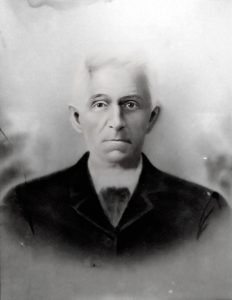
Alvey Morden
In 1874 Alvey Morden – hardy, courageous, and filled with hope – left Walkerton, Ontario for the far West. With him came his four sons, Wilmot, Frank, Albert and David, and daughter Elizabeth. They were among the first to come to the immediate vicinity of present-day Morden. It is believed the only nearby settler to precede the Mordens was George Cram who homesteaded one mile north of Alvey Morden.
By 1878 there were three post offices in this area; Minnewasta serving what is now the Morden district, Nelson and Mountain City. Of these Nelson became the most prosperous boasting a population of nearly 1,000 in 1881. Much of the success of Nelson came as a result of the Land Registry Office placed there to accommodate the Ontario English, who were settling to the west. The new settlers used Nelson as a stopping-off place on the way to their homestead claims. Agriculture became the most important industry in this area.
The Mort Cheval Creek
It was the building of the railway by the Canadian Pacific, which brought Morden into prominence. The rail line bypassed the established settlements and in 1882 reached the spot which is now Morden. The Mort Cheval Creek provided water for the steam locomotives and prompted the railway to immediately build a water tower at the creek crossing. They named the stopping place “Cheval” and in a few months changed it to “Morden” after the original owner of the property.
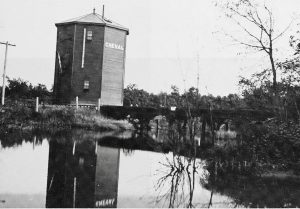
As soon as the railway decided on the Morden route and the town site was laid out at Morden both Mountain City and Nelsonville had to make up their minds what to do. As the residents’ cherished dreams of a railroad through their communities faded, many pulled up stakes and moved lock, stock and barrel to Morden. The moving of buildings became an art. They were raised onto skids of oaken beams and with snow on the ground the people moved one building a day. Those who observed the moving said it was an unforgettable sight to witness the horses supplying the power. At the word, they leaned into their collars for quite a period of time until the building started to move. Once it was in motion it was kept going until it arrived at its destination in Morden. By 1885 most of the businesses of both boom towns had vanished and by 1900 hardly a building remained at either Mountain City or Nelsonville. Meanwhile, the new town of Morden had developed into a large, well-equipped town of over 1,500 people.
Healthcare Milestones: From Freemason’s Hospital to Boundary Trails
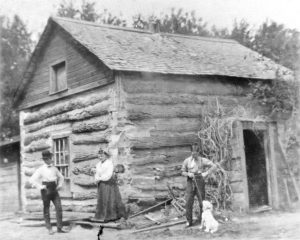
The first school at Morden was actually 1 mile south at the corner of the Willcocks farm. It was a one-room school built of oak logs, ordered to be established by the council of South Dufferin (Mountain City) and the new Maple Leaf School Division #83 in 1881. The second school, a building which contained two large rooms was constructed in 1883 on the southwest corner of Nelson and Stephen Streets where the Buhler building now stands. The third building was a four-room building which was moved in two sections from Nelsonville in 1886. It stood for many years on 6th Street where the Church of God now stands and was used until about 1908. In 1893 a fourth school, the Morden Intermediate High School was built. This had six rooms and was built of granite boulders from the hills west of Morden. Opened in September 1894, the school grounds were three acres on the north side of Thornhill between 10th and 11th Streets. A modern one-story six-room elementary school was built in 1928, adjoining the high school. This school, Maple Leaf Elementary was enlarged in 1980 and is still in use today as an early years facility. In 1952 a combined high school and elementary school was built at Wardrop and 4th Streets. Since 1965 this building has been an early and middle years school and recently has added an early years French Immersion program. The high school students are being taught in the Morden Collegiate Institute, 354 – 5th Street, built in 1965. The newest addition to the Western School Division (formed in 1961) is the Minnewasta School, an early years facility built in 1990 on Academy Drive.
Hospital service has been available to the residents of Morden District for over 100 years, a longer period than anywhere else in rural Manitoba. The cornerstone for the first Hospital, known as the “Freemason’s Hospital” was laid on June 9th, 1892, by the Grand Master of the Masonic Order, to which Order must go the credit for recognizing the need for such health care, and making this provision to meet that need. The only other Hospitals in Manitoba that preceded this one were St. Boniface Hospital, established in 1871, Winnipeg General (now Health Sciences Centre) in 1875 and Brandon General in 1890.
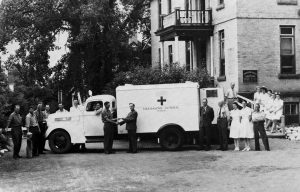
In 1898 a nurse’s training program was begun and a nurse’s residence was built. In 1900 an operating table and a wheelchair were acquired. The first isolation ward was established in 1901, following the admittance of a patient infected by the dreaded smallpox disease. The nurse’s training program was discontinued in 1942 and a practical nurses course was introduced in 1945, it terminated in 1979. A new wing, named for Judge Locke was added in 1922 and was large enough for four semi-private rooms.
The local Kinsmen Club donated the first ambulance in 1946 and in 1949 an incubator was installed in the hospital and a new operating table and X-ray machine were purchased.
In 1952 the Morden District General Hospital was built and the Freemasons Hospital was sold to the Mennonite Brethren Church, remodeled and re-opened as the Tabor Senior Citizens Home. It served this purpose until the present Tabor Home was built in 1969. 2001 saw the beginning of a new era of health care when the ultra-modern Boundary Trails Health Centre opened at the junction of Highways 3 and 14. This new regional facility serves the towns of Morden and Winkler and most of south-central Manitoba.
Infrastructure Growth: Electricity and Telecommunications
Electricity came to Morden in 1895 when Mr. Garrett opened the first plant. It served until 1923 when it was bought by the Manitoba Power Commission.
The Bell Telephone office opened in Morden in 1890 and was one of the first in rural Manitoba. In 1905 the Manitoba government bought the system from Bell. Twenty-four-hour service was initiated in 1906 and then in 1935, the town was canvassed to increase subscriptions and reduce service charges. In 1957, a brief was presented to Manitoba Telephone System which resulted in the installation of a dialing system a few years later.
Under the leadership of civic and community organizations the town’s modern-minded population encouraged many improvements. One of the earliest important additions to the town was the establishment in 1915 of the Dominion Experimental Station adjoining the east borders of Morden. Early settler A.P. Stevenson had an avid interest in horticulture. He started an orchard on his homestead and provided many Manitobans with apples, plums and other fruits as well as nursery stock for many years. Stevenson is credited with growing one of the first apple crops on the prairies and proved how rich the land around Morden was, and what a variety of crops it could grow. The Federal government’s decision to place the research station here was due to his work.
Floods, Dams, and Waterworks
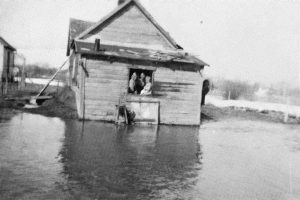
Floods have been a part of the history of the town. The Dead Horse Creek, which runs through the town from the southwest, gathers the drainage water from a large area. Probably the worst flood Morden experienced came in 1932, in the middle of the drought. A cloudburst to the west on May 23 caused the Creek to spill its banks and rampage through the town, causing havoc.
There were other improvements, but the most important was the setting up of waterworks and sewage disposal by the town in 1950. This was made possible by the building of the P.F.R.A. dam in 1941 and enlarged in 1953, across the ravine of Dead Horse Creek and creating Lake Minnewasta, just a mile west of town.
It was after the Second World War that there was a resurgence of interest in this area and new inhabitants settled in and around Morden. Revived hope, new ideas and greater economic stability brought prosperity and encouraged development. The old “push” was back – people again thought that Morden deserved what other thriving towns already had. During those years, nearly three million dollars were expended in the building of homes, institutions and industrial expansion. The population figures now reached the 3,300 mark.
Today, diversification is the keyword to Morden’s dynamic growth. The community has utilized its natural advantages to bring in industry and promote tourism, to give the City stability and optimism envied by many.
